An effective structure is at the heart of any successful response to a case interview question.
A good case interview structure should identify the right question, present a comprehensive set of independent drivers, and provide a prioritized and insightful approach to solving the case.
The good news is that there are a number of established frameworks that can help you structure your responses to case questions. Learning how to apply these frameworks correctly, however, is a skill in itself.
In this guide, we introduce the 10 most helpful frameworks for structuring responses to case questions, and explain how to use them effectively.
Key takeaways
- Case interview frameworks can be incredibly helpful for structuring your responses to case questions, but it’s vital to learn how to use them.
- Many of the top-10 frameworks can help you structure responses to common case questions, such as those on profitability, revenue growth, market entry, cost cutting, and process optimization.
- The other frameworks covered in this article are: supply and demand, the three Cs, Porter’s Five Forces, the four Ps, and BCG’s growth-share matrix.
- Simply applying a framework to a case in a ‘cookie-cutter’ fashion won’t help you produce the best possible answer. Interviewers want to see that you are capable of proposing custom case interview structures.
- It’s vital to gain an in-depth understanding of case interview frameworks before you can put them into practice. The video lectures in our Interview Prep Course cover 20+ frameworks in detail.
- Learning how to use the frameworks to create custom structures takes a great deal of practice. The structuring drills in our Interview Prep Course can help you build your skills and confidence quickly.
The top-10 case interview frameworks
The profitability framework
The profitability question in a case interview is a classic. In our analysis of the types of case questions most commonly asked by McKinsey, BCG and Bain, profit improvement topped the list, accounting for 20% of the case questions reported.
As illustrated in the graphic below, profit is defined as revenue minus cost, where revenue is the quantity sold multiplied by the price of the product. The standard approach to thinking about profit is illustrated in the diagram below:
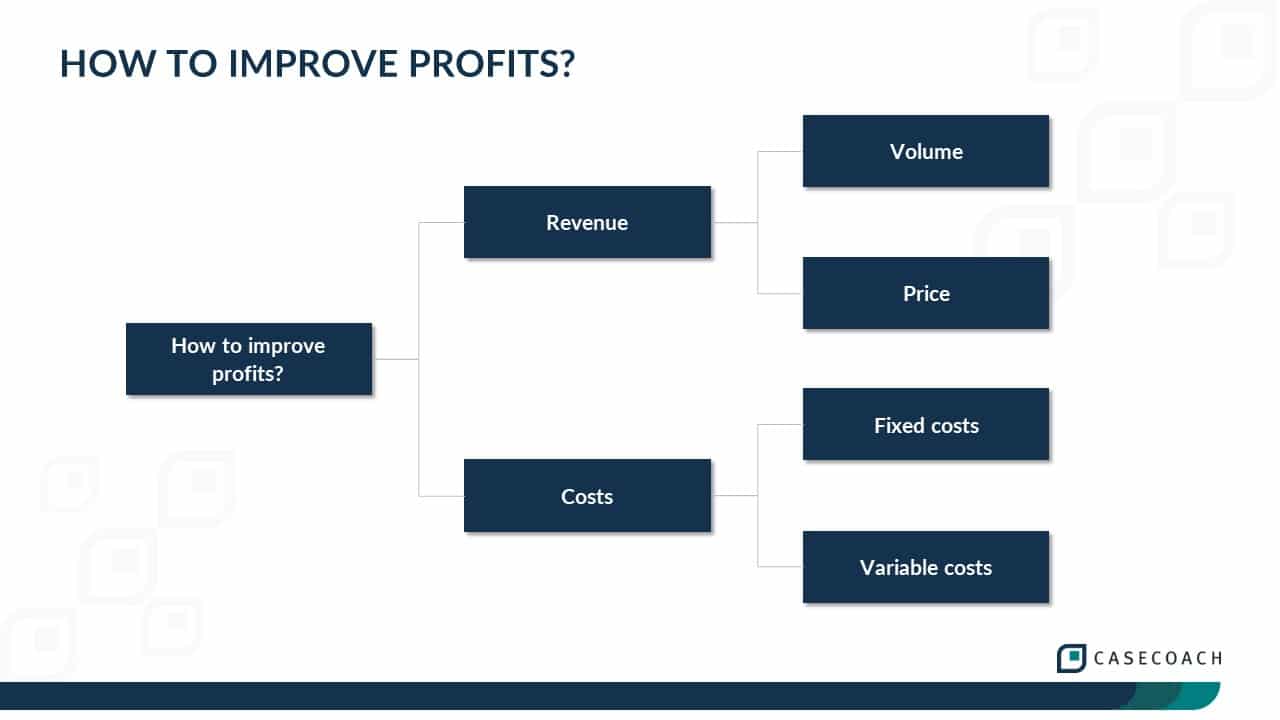
We’ve built on this framework to provide a more sophisticated approach that will help you identify how to increase revenue or reduce costs in a case interview. You can learn more in our article on using the profitability framework to answer case questions.
The revenue growth framework
The chances of being faced with a revenue growth question in a case interview are also very high. In our analysis of common case questions, revenue growth was the second-most frequently cited topic.
The revenue growth framework is based on the principle that there are two main ways to grow a company’s revenue:
- Growing its core business
- Growing outside of its core business
To use this revenue growth framework in a case interview, draw two branches or ‘buckets’ to represent the main ways to grow a business. Then unpack the next level of detail in each subsequent branch, as shown in the example below:
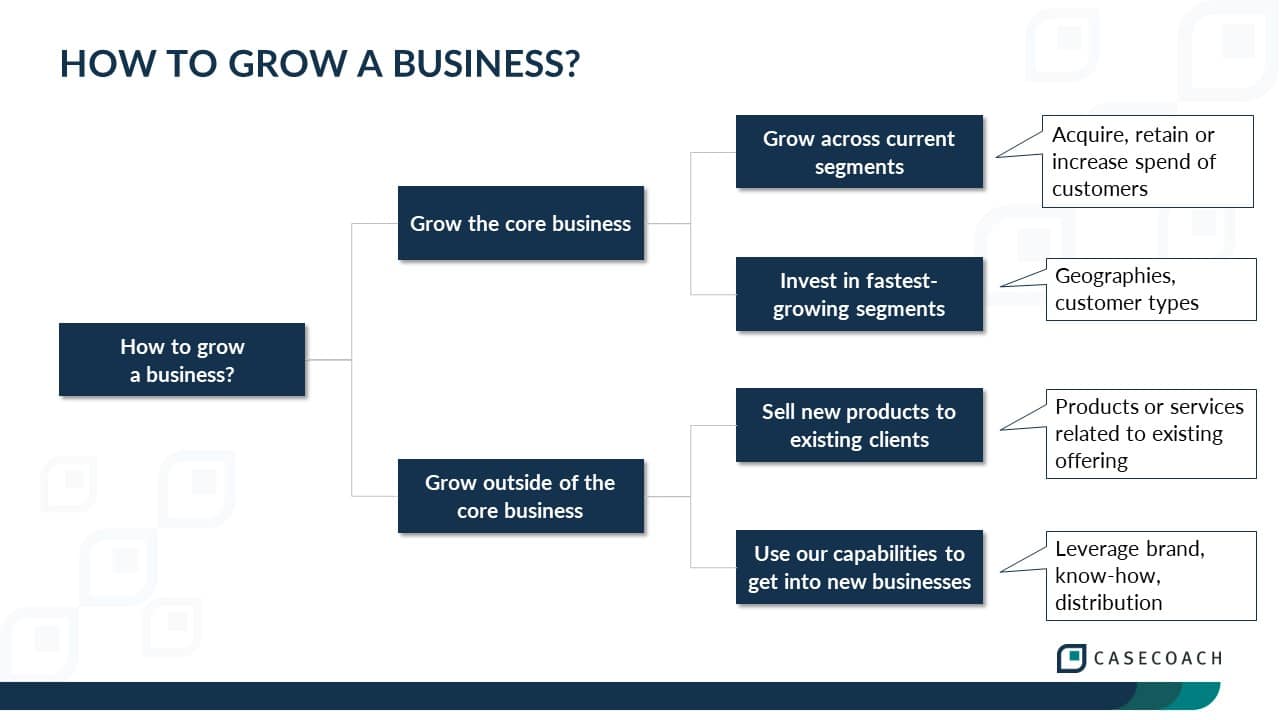
You can learn more in our article on using the revenue growth framework to answer case questions.
The market entry framework
When it comes to a market entry question in a case interview, there are four drivers to consider:
- How big is the market opportunity?
- What kind of share of that market can the client capture?
- Assuming that this share is captured, how much profit can the client make?
- If that profit is attractive, what are the client’s capabilities and what risks are involved?
To identify the size of the market opportunity, you need to know the size and growth of the market.
To understand the share of the market that you can capture, look at the competitive landscape and what customers want, and then compare this to your offering. You might conclude that this is a good opportunity. Alternatively, you might find that the market is already dominated by a small number of powerful players and will therefore be difficult to enter.
To determine potential profit, look at the initial investment coupled with the running cost, and then compare it to the revenue that you can expect.
The market entry framework is illustrated in the graphic below:
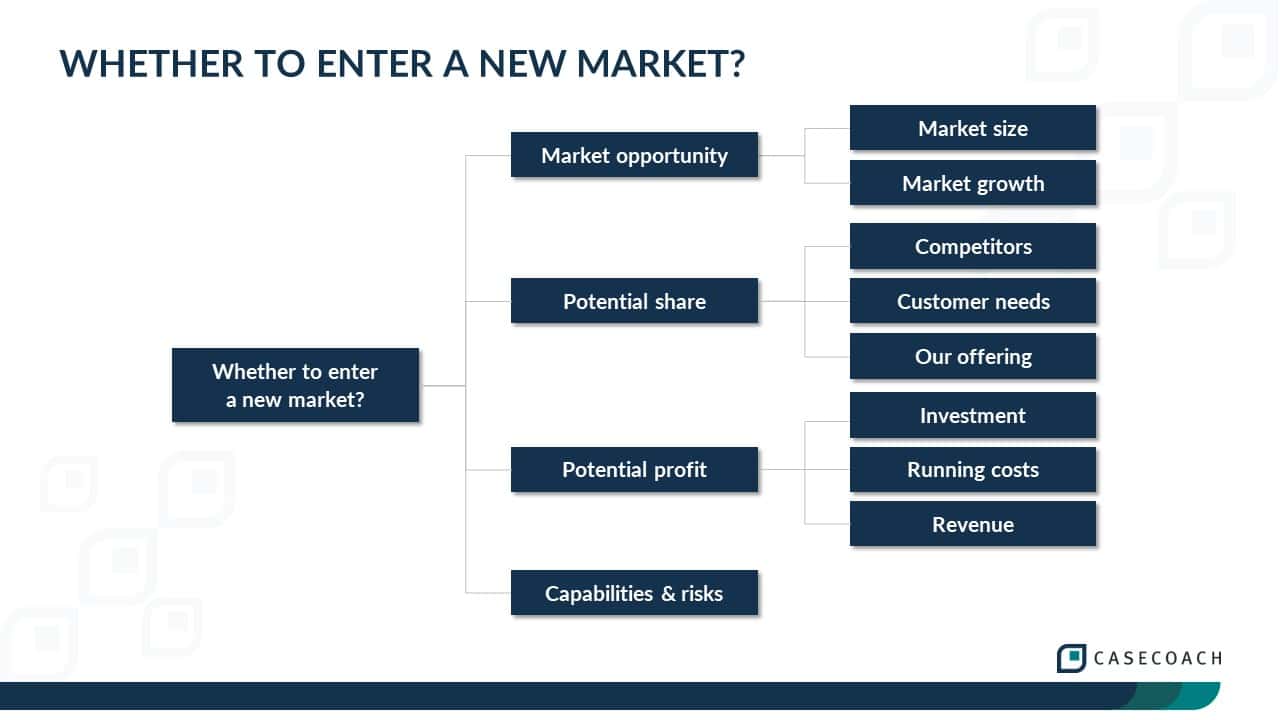
The cost-cutting framework
The cost-cutting framework presents three main drivers for reducing cost:
- Reducing the need for what you’re buying
- Meeting the need with fewer resources
- Reducing the cost of the resources
To reduce the need for what you’re buying, you could either eliminate the need entirely or reduce the level of service that you provide.
To meet the need with fewer resources, you could look at ways to either eliminate waste in the process or improve productivity.
To reduce the cost of the resources, you could renegotiate your existing contracts or find cheaper alternatives.
The cost-cutting framework is illustrated in the graphic below:
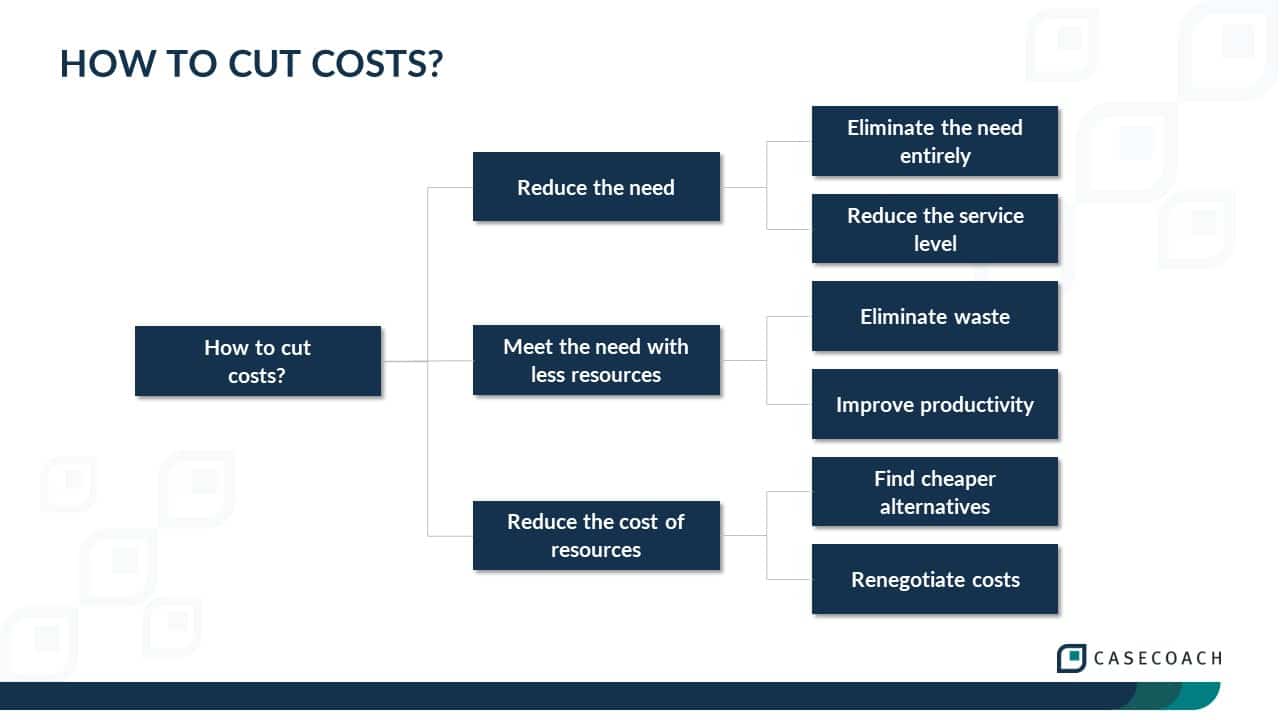
The process optimization framework
This framework sets out a three-part methodology for optimizing a process:
- Map out the current process
- Look at how to improve each step of the process
- Estimate the gains
When mapping out the current process, there are a few key questions about each step of the process that you need to ask:
- What’s the capacity of that step?
- Is it being fully utilized?
- Is it a bottleneck that’s limiting the capacity of the overall process?
When looking at how you can improve each step of the process, keep the client’s goal in mind. Is their objective to increase capacity, improve reliability, or decrease costs?
Depending on the answer, you might identify a need to reduce the cost of that step, increase its speed, improve its quality, or maybe include the step earlier in the process. You might even want to eliminate it entirely.
Once you’ve done this, map out the new process and estimate the gains.
The process optimization framework is illustrated in the graphic below:
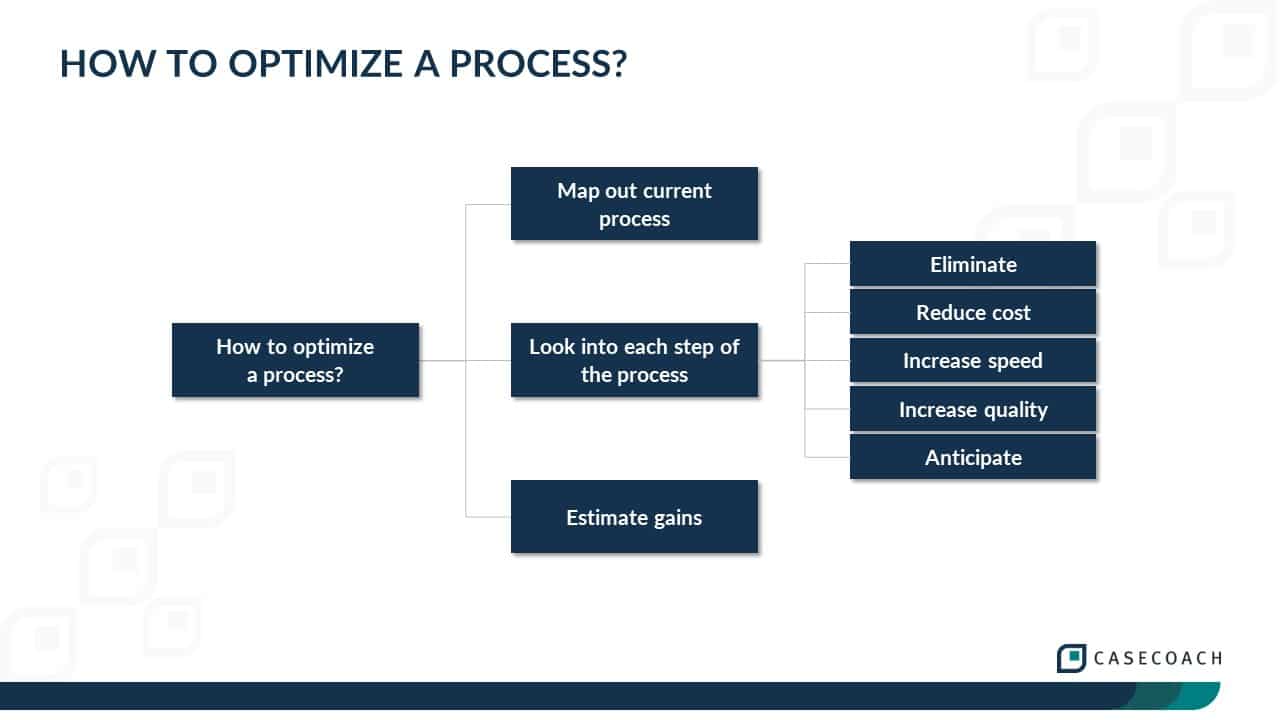
Supply and demand
Supply and demand is the law of gravity that rules markets. Its core principles are very straightforward:
- On the one hand, demand for a product or a service increases when the price goes down.
- On the other hand, more suppliers are ready to provide the product or the service when the price goes up.
As illustrated in the graphic below, these two curves meet at the ‘price/quantity equilibrium’, where supply equals demand:
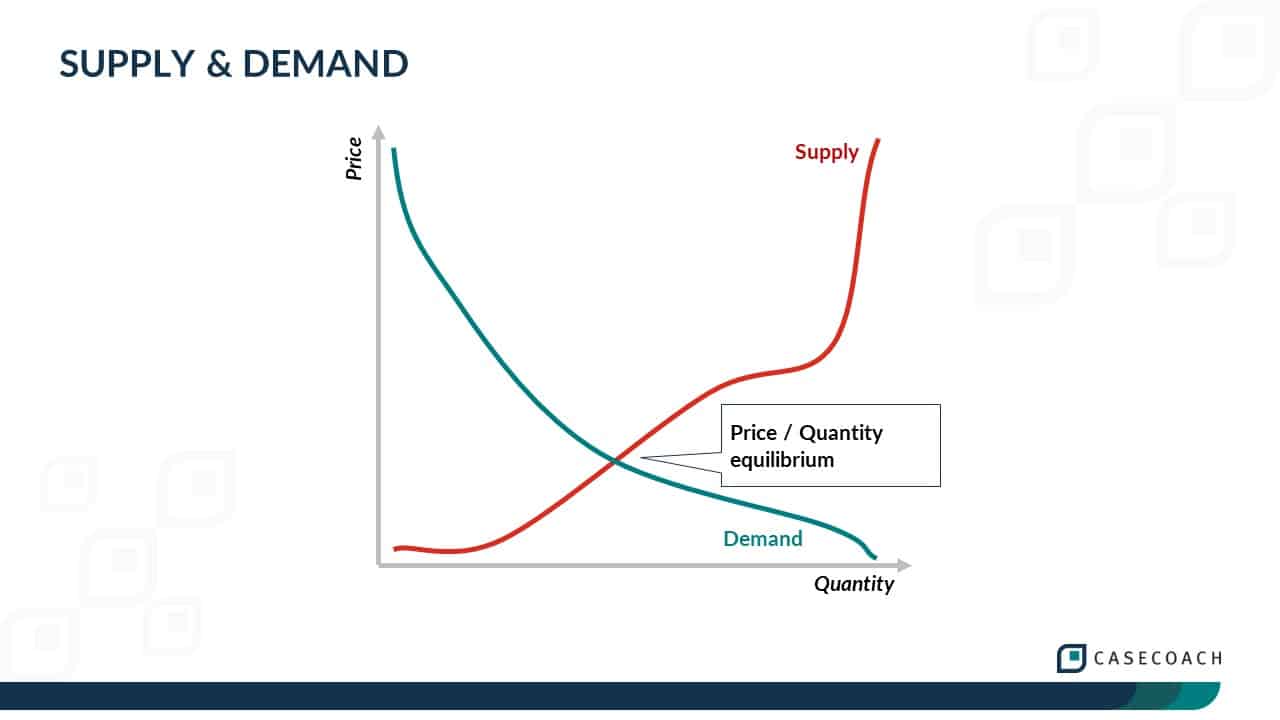
The supply and demand framework helps us understand how all sorts of markets behave. In business, we can use it to:
- estimate the impact of our interventions
- forecast profits
- make investment decisions
- analyze operational problems, where supply or capacity is typically constrained (e.g. in a shop, call center, or production line)
Outside of business, supply and demand can inform policy-making in areas such as housing, labor, and recruitment needs.
The three Cs framework
The three Cs is one of the most frequently used strategy frameworks. It was created by a Japanese management consultant who later became an academic.
As illustrated in the graphic below, the three ‘Cs’ refer to:
- the company
- its competitors
- its customers
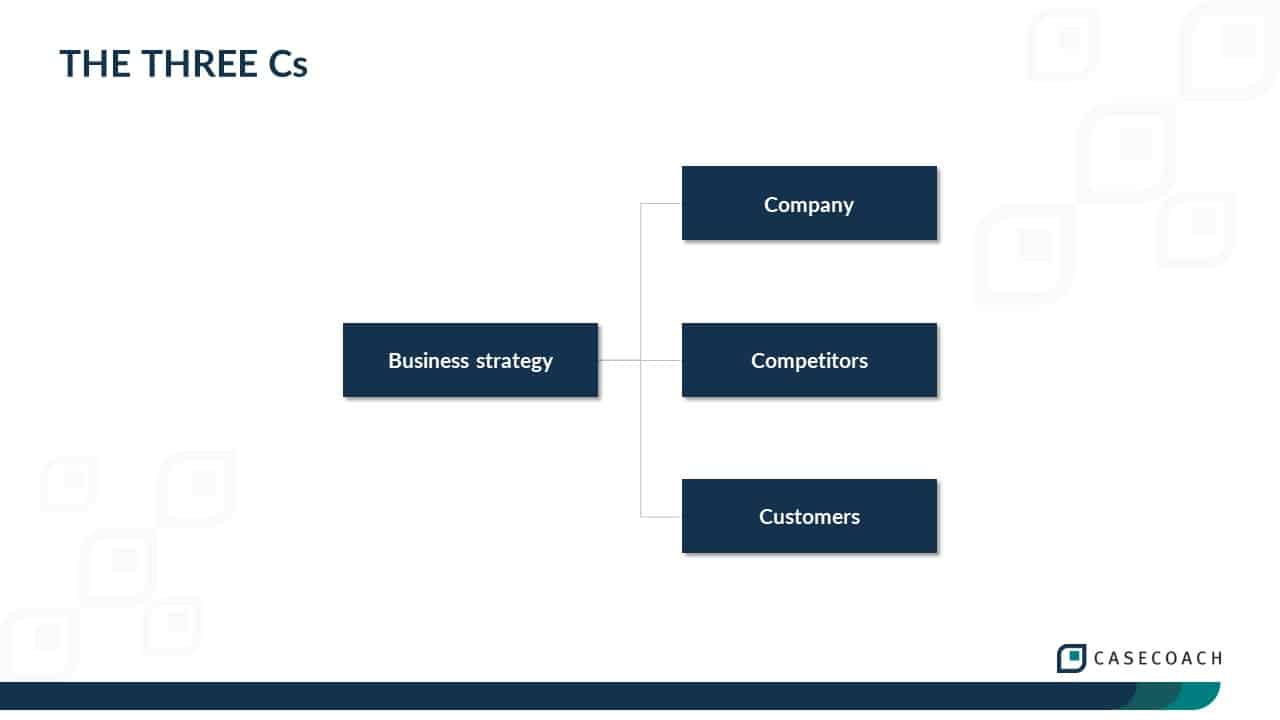
Underpinning the framework is the theory that if a company wants to win in a market, it needs to satisfy its customers’ needs more successfully than its competitors.
Porter’s Five Forces
Porter’s Five Forces builds on the frameworks of both supply and demand and the three Cs. Developed by star Harvard Business School professor Michael Porter, the framework looks at the attractiveness of a market through the lens of five drivers or ‘forces’. These are:
- customers
- competitors
- substitutes
- new entrants
- suppliers
The framework is illustrated in the graphic below:
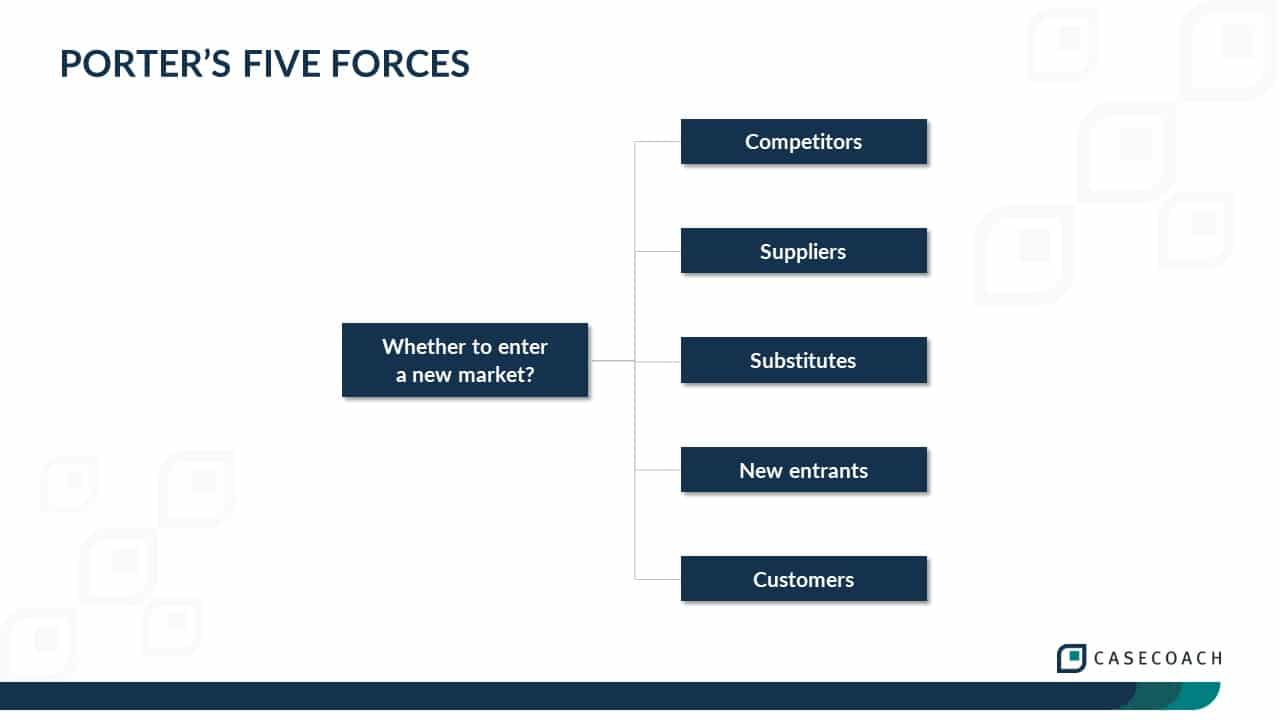
Best suited to market entry questions, Porter’s Five Forces helps us understand the attractiveness of an industry and whether a company should enter a particular market. If an industry has many competitors, substitutes, and new entrants, for example, this could signal a low barrier to entry, little competitive advantage, and low margins.
The four Ps framework
The four Ps framework, also known as the ‘marketing mix’, can help a company establish an effective strategy for launching a new product. The framework focuses on four key areas:
- Product – which can be defined as what’s being offered (i.e. a product’s features, design, and brand)
- Price – which may involve sophisticated strategies and competitive differentiation
- Place – which will typically focus on distribution channels and partnerships
- Promotion – which could include advertising, communication, and public relations
To succeed in marketing a product, a company should make sure that each of the four Ps is aligned closely to the target market segment, as illustrated in the example below:
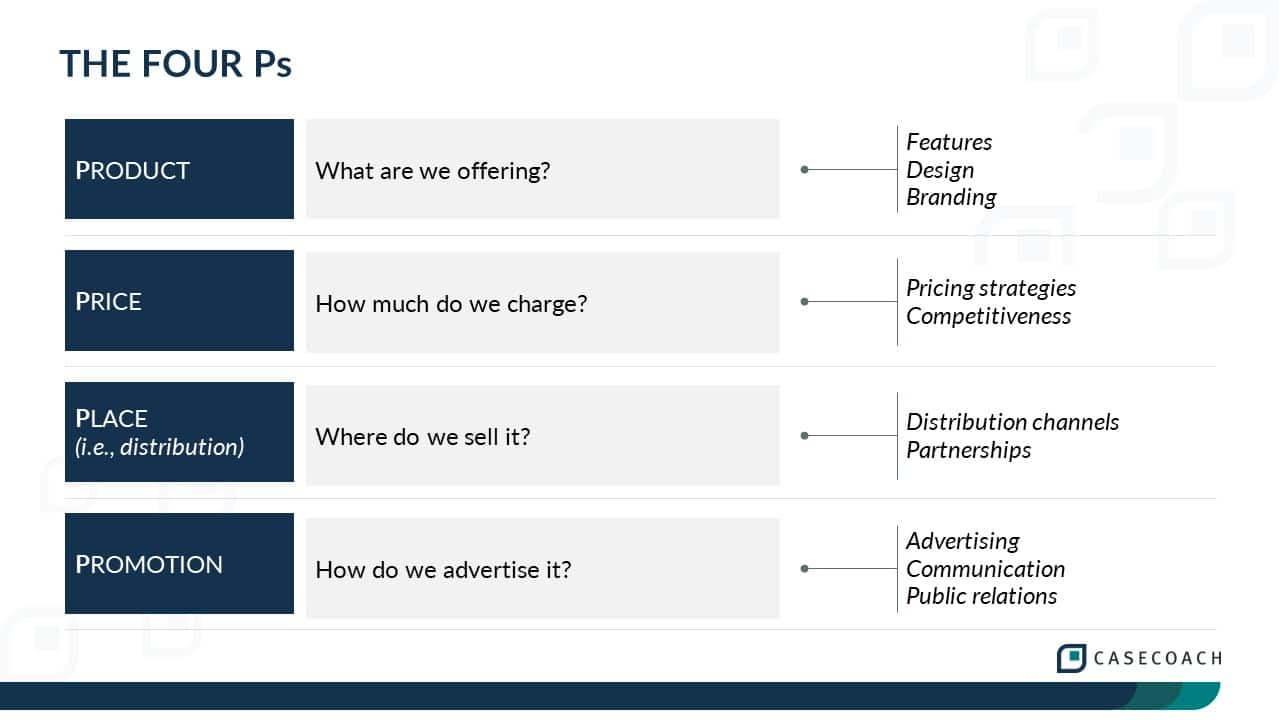
We’ve used elements of the four Ps in our product launch framework, which you’ll find in our Interview Prep Course.
The BCG growth-share matrix
Created and popularized by BCG, one of the world’s top management consulting firms, the growth-share matrix is a framework that helps large corporations decide how to invest among their business units for the greatest growth.
The framework classifies potential investment areas into four categories based on the growth of the industry and the company’s relative market share:
- ‘Pet’: Low market share in a slow-growing market. Pets should be liquidated, divested or repositioned.
- ‘Cash cow’: High market share in a slow-growing market. Cash cows are profitable and should therefore be ‘milked’ (i.e. managed to maximize profitability).
- ‘Star’: High market share in a fast-growing market. Stars should be invested in as they have the potential to become cash cows in the future.
- ‘Question mark’: Low market share in a fast-growing market. Depending on their potential to become stars, question marks should either be invested in or discarded.
The matrix is illustrated in the graphic below:
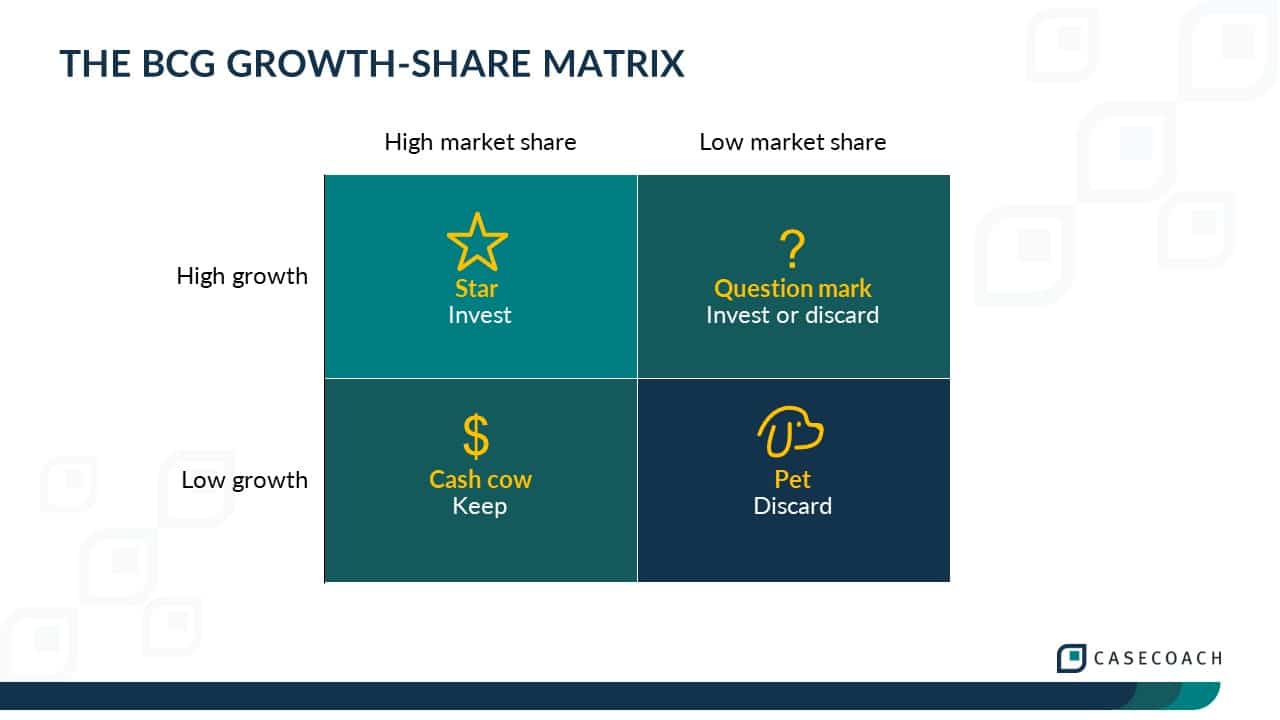
We’ve incorporated some elements of the BCG growth-share matrix into our revenue growth framework.
How to use case interview frameworks
The frameworks we’ve covered here can help you greatly with structuring responses to case questions. It’s therefore vital to learn them as part of your case interview preparation.
However, simply applying a framework to a case interview question in a ‘cookie-cutter’ fashion is not enough. This approach will neither produce the best possible answer nor allow you to impress your interviewer.
Even the most common types of case questions require a custom structure. A profitability question that relates to a chain of restaurants, for example, will naturally require a different approach to a question on the same topic in the manufacturing industry.
Many case questions will require you to combine different frameworks and use them as building blocks for crafting your answer. A profitability question may have a focus on market growth or launching a product, for example.
Ultimately, interviewers want to understand how your mind works and see you think on your feet. You’ll therefore need to demonstrate that you can propose a custom case interview structure to any question.
How to practice creating case interview structures
1. Learn the theory
To master the art of using these frameworks effectively in a case interview, the first step is to learn the theory behind them.
We teach everything you need to know about most of the frameworks covered in this article – along with over 10 others – in our Interview Prep Course.
Designed to help you tackle each dimension of the case and fit interviews, the course contains all the video lectures, sample interviews, case material, and practice tools you’ll need to ace any case interview.
2. Hone your structuring skills with drills
Structuring is one of the case interview skills you can practice alone, using drills to build your skills and confidence quickly. Drills are interactive exercises that pose rapid-fire questions and then provide instant feedback.
Our Interview Prep Course includes a comprehensive set of structuring drills, which provide scope for posing clarifying questions. They also offer multiple solutions to each problem to illustrate the diversity of thinking that you can apply when structuring a custom response to a case question.
During your preparation, we recommend spending 20-30 minutes every day reviewing case questions, developing structures for them, and then evaluating their effectiveness.
3. Practice live cases with a partner
Nothing can beat practicing live cases with a partner. In fact, most candidates who go on to receive an offer from a top consulting firm like McKinsey, BCG or Bain complete at least 25 live practice sessions before their interview.
At CaseCoach, we can connect you with a diverse community of fellow candidates who are all available for case interview practice in our Practice Room.
Ultimately, the frameworks covered in this article can help you craft compelling and memorable responses to case interview questions. However, to produce the best possible answers and impress your interviewers, you must use these frameworks to propose custom case interview structures. This is a skill that requires a great deal of practice to develop and hone.







